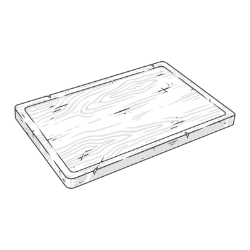
How to Install a Farmhouse Sink in Existing Cabinets: Easy Steps [2023]

If you're remodeling your kitchen, hefty installation fees can quickly add on to your design expenses. However, there's something you can do on your own to save money.
Simply follow our steps in this guide, and you'll learn how to install a farmhouse sink in existing cabinets in no time!
How to Install a Farmhouse Sink in Existing Cabinets
Tools and Supplies You'll Need
For this job, you'll need a few things on-site or in your kitchen [1] to aid you throughout the process.
These include measuring tools, safety goggles, a pencil/marker, a jigsaw/oscillating saw, construction adhesive, wood blocks, screws, a screw gun, and an electric drill.
If you're not comfortable using these tools, consider hiring a professional to help you build your new kitchen.
Otherwise, proceed with the rest of the guide! Just remember to follow all the necessary safety precautions and wear the correct protective equipment throughout the whole project.
After all, it's always your safety first!
Take Measurements of Sink and Cabinet
First, measure your existing cabinet. You want to make sure that the new sink fits properly when you put it in, so it's a good idea to take your time with these measurements.
Get the width, the distance from the top to the bottom of the drawer opening or screw holes, and the distance from the top of the cabinet to the doors.

This is so you know it can accommodate the farm sink and that nothing will interfere with the apron front.
Next, assess the length, width, and height of your sink to check if all your measurements line up.
Once that's done, you're ready for the actual work!
Remove the Counters
If your counter top is screwed on, simply use a screw gun to remove the fastenings, and lift it out. Alternatively, if the counter top is glued down, you can use an oscillating saw to pry it out.
Ideally, you'll be able to remove the counter top in one piece. However, if it is very large, you may have to cut it up into pieces and remove them one by one before proceeding.
Cut the Cabinet's Front, Top and Back Portions
To put in a farm sink, you have to cut out the existing cabinet front, top, and even back, depending on how much space you need. Since these types of sinks have their aprons exposed, it's important for you to follow the template that comes with your farm sink.
Trace out the template precisely, then use a jigsaw or an oscillating saw to cut out the outline. If you want to err on the side of caution, you can saw inside the lines and sand the excess to prevent overcutting.
Next, cut and attach the supporting frames. Because farm sinks are very heavy, they require adequate support.
It's vital that you account for the sink measurements before installing these wooden support blocks. Once you're certain everything fits, use construction adhesive to glue horizontal and vertical supports inside the cabinet, then secure them with screws.
Install New Counters
Now that you know the farm sink fits perfectly, it's time to reinstall your counter top. If you were able to remove the whole counter in the previous step, you may not have to change it to a new one.
However, if you do want to change it, consider the material of your new counter top.
Although wood and laminate are popular options, they're more prone to water damage. Materials such as marble, granite, and quartz can be pricier, but they're also sturdier.
While you can opt to install this on your own, it can be difficult, especially for beginners. If you've purchased new ones, the company will typically provide a free service to help you out.
Install the Sink
The next part of the job is sink installation. Since it's very heavy, you'll definitely need some help with this!
Carry your sink over to the opening you made, and slide it in so it's flush with the counter top. Double-check that everything's straight and level so you don't encounter problems later on while using it.
Remember, since you installed the counter top beforehand, you should be using a top-mount sink or a flush-mount sink. If you prefer an undermount sink, the counter should be put in after.
Trim the Edges
All that's left to do is trim the edges for a more refined and polished look. Now you know how to install a farm house sink in existing cabinets for your kitchen!
Frequently Asked Questions
Can you put a farmhouse sink in existing cabinets?
Yes, you definitely can!
Something you should keep in mind, though, is you'll have to cut out the front of the cabinet and remove the counter top prior to farm sink installation.
If you want to make the job easier, consider getting a retrofit farmhouse sink, which is meant for a standard kitchen sink base.
Since these types of sinks have shorter aprons, you won't have to do any heavy cutting.
How do you install a farmhouse sink in old cabinets?
First, take measurements to ensure a proper fit. Remove the old kitchen counters to prepare for installation.
Then, cut out the portions that interfere with the sink. Install the new counters and sink; trim off any excess material, and you're done!
Something you should remember, though: Since these types of sinks are heavier than standard ones, old cabinets may not provide enough support.
Wood blocks are great things to add strength and durability to the frame.
Conclusion
Clearly, you don't have to be a professional to learn how to install a farmhouse sink in existing cabinets. By following the simple directions above, you can definitely do it on your own!
With the right tools and the right mindset, your efforts can go a long way (and save you more money in the long run). Plus, you'll be gaining a new skill that you can use for a long time.
Good luck!





